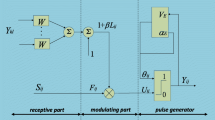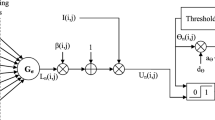Abstract
Medical image segmentation is a challenging task especially in multimodality medical image analysis. In this paper, an improved pulse coupled neural network based on multiple hybrid features grey wolf optimizer (MFGWO-PCNN) is proposed for multimodality medical image segmentation. Specifically, a two-stage medical image segmentation method based on bionic algorithm is presented, including image fusion and image segmentation. The image fusion stage fuses rich information from different modalities by utilizing a multimodality medical image fusion model based on maximum energy region. In the stage of image segmentation, an improved PCNN model based on MFGWO is proposed, which can adaptively set the parameters of PCNN according to the features of the image. Two modalities of FLAIR and T1C brain MRIs are applied to verify the effectiveness of the proposed MFGWO-PCNN algorithm. The experimental results demonstrate that the proposed method outperforms the other seven algorithms in subjective vision and objective evaluation indicators.
Similar content being viewed by others
References
Bai X Z, Zhang Y X, Liu H N, Wang Y F. Intuitionistic center-free FCM clustering for MR brain image segmentation. IEEE Journal of Biomedical and Health Informatics, 2019, 23, 2039–2051.
Chen H P, Xie Z Y, Huang Y P, Gai D. Intuitionistic fuzzy C-means algorithm based on membership information transfer-ring and similarity measurement. Sensors, 2021, 21, 696–713.
Mansoor A, Bagci U, Xu Z, Foster B, Olivier K N, Elinoff J M, Suffredini A F, Udupa J K, Mollura D J A. Generic approach to pathological lung segmentation. IEEE Transactions on Medical Imaging, 2015, 34, 2293–2310.
Sahoo A, Chandra S. Multi-objective grey wolf optimizer for improved cervix lesion classification. Applied Soft Computing, 2016, 52, 64–80.
Li L G, Sun L J, Kang W, Guo J, Han C, Li S J. Fuzzy Multilevel image thresholding based on modified discrete grey wolf optimizer and local information aggregation. IEEE Access, 2016, 4, 6438–6450.
Khairuzzaman A K M, Chaudhury S. Multilevel thresholding using grey wolf optimizer for image segmentation. Expert Systems with Applications, 2017, 86, 64–76.
Adhikari S K, Sing J, Basu D K, Nasipuri M. Conditional spatial fuzzy C-means clustering algorithm for segmentation of MRI images. Applied Soft Computing, 2015, 34, 758–769.
Verma H, Agrawal R K, Sharan A. An improved intuitionistic fuzzy c-means clustering algorithm incorporating local information for brain image segmentation. Applied Soft Computing, 2016, 46, 543–557.
Long J, Shelhamer E, Darrell T. Fully convolutional networks for semantic segmentation. IEEE Transactions on Pattern Analysis and Machine Intelligence, 2017, 39, 640–651.
Lian J, Yang Z, Sun W H, Guo Y N, Li Z, Li J P, Shi B, Ma Y D. An image segmentation method of a modified SPCNN based on human visual system in medical images. Neurocomputing, 2019, 333, 292–306.
Eberhart R, Kennedy J. A new optimizer using particle swarm theory. MHS’95. Proceedings of the Sixth International Symposium on Micro Machine and Human Science, Nagoya, Japan, 1995, 39–43.
Whitley D. A genetic algorithm tutorial. Statistics and Computing, 1994, 4, 65–85.
Duan H B, Qiao P X. Pigeon-inspired optimization: A new swarm intelligence optimizer for air robot path planning. International Journal of Intelligent Computing and Cybernetics, 2014, 7, 24–37.
Dorigo M, Maniezzo V, Colorni A. Ant system: Optimization by a colony of cooperating agents. IEEE Transactions on Systems Man Cybernetics, Part B, 1996, 26, 29–41.
Mirjalili S, Mirjalili S M, Lewis A. Grey wolf optimizer. Advances in Engineering Software, 2014, 69, 46–61.
Liu Y, Mu C H, Kou W D, Liu J. Modified particle swarm optimization-based multilevel thresholding for image segmentation. Soft Computing, 2015, 19, 1311–1327.
Gai D, Shen X J, Chen H P, Xie Z Y, Su P X. Medical image fusion using the PCNN based on IQPSO in NSST domain. IET Image Processing, 2020, 14, 1870–1880.
Yin P Y. A fast scheme for optimal thresholding using genetic algorithms. Signal Processing, 1999, 72, 85–95.
Wang Y, Zhang G B, Zhang X F. Multilevel image Thresholding using tsallis entropy and cooperative pigeon-inspired optimization bionic algorithm. Journal of Bionic Engineering, 2019, 16, 954–964.
Mirjalili S, Saremi S, Mirjalili S M, Coelho L S. Multi-objective grey wolf optimizer: A novel algorithm for multi-criterion optimization. Expert Systems with Applications, 2016, 47, 106–119.
Faris H, Aljarah I, Al-Betar M A, Mirjalili S. Grey wolf optimizer: A review of recent variants and applications. Neural Computing and Applications, 2018, 30, 413–435.
Gupta S, Deep K. A novel random walk grey wolf optimizer. Swarm and Evolutionary Computation, 2019, 44, 101–112.
Liu X B, Mei W B, Du H Q. Structure tensor and nonsubsampled shearlet transform based algorithm for CT and MRI image fusion. Neurocomputing, 2017, 235, 131–139.
Zhu Z Q, Zheng M Y, Qi G Q, Wang D, Xiang Y. A phase congruency and local laplacian energy based multi-modality medical image fusion method in NSCT domain. IEEE Access, 2019, 7, 20811–20824.
Mech L D. Alpha status, dominance, and division of labor in wolf packs. Canadian Journal of Zoology, 1999, 77, 1196–1203.
Muro C, Escobedo R, Spector L, Coppinger R. Wolf-pack (Canis lupus) hunting strategies emerge from simple rules in computational simulations. Behavioural Processes, 2011, 88, 192–197.
Hempelmann C, Sakoglu U, Gurupur V, Jampana S. An entropy-based evaluation method for knowledge bases of medical information systems. Expert Systems with Applications, 2016, 46, 262–273.
Xydeas C S, Petrovic V. Objective image fusion performance measure. Electronics letters, 2000, 36, 308–309.
Hossny M, Nahavandi S, Creighton D. Comments on ‘information measure for performance of image fusion’. Electronics Letters, 2008, 44, 1066–1067.
Johnson J L, Padgett M L. PCNN models and applications. IEEE Transactions on Neural Networks, 1999, 10, 480–498.
Eckhorn R, Reitboeck H J, Arndt M, Dicke P. Feature linking via synchronization among distributed assemblies: Simulations of results from cat visual cortex. Neural Computation, 1990, 2, 293–307.
Bezdek J C, Ehrlich R, Full W. FCM: The fuzzy c-means clustering algorithm. Computers & Geosciences, 1984, 10, 191–203.
Bai X Z, Chen Z G, Zhang Y, Liu Z Y, Lu Y. Infrared ship target segmentation based on spatial information improved FCM. IEEE Transactions on Cybernetics, 2016, 46, 3259–3271.
Lei T, Jia X H, Zhang Y N, He L F, Meng H Y, Nandi A K. Significantly fast and robust fuzzy C-means clustering algorithm based on morphological reconstruction and membership filtering. IEEE Transactions on Fuzzy Systems, 2018, 26, 3027–3041.
Acknowledgment
This research is supported by the National Key Research and Development Program of China (2018YFB0804202, 2018YFB0804203), Regional Joint Fund of NSFC (U19A2057), the National Natural Science Foundation of China (61672259, 61876070), and the Jilin Province Science and Technology Development Plan Project (20190303134SF, 20180201064SF).
Author information
Authors and Affiliations
Corresponding author
Rights and permissions
About this article
Cite this article
Wang, X., Li, Z., Kang, H. et al. Medical Image Segmentation using PCNN based on Multi-feature Grey Wolf Optimizer Bionic Algorithm. J Bionic Eng 18, 711–720 (2021). https://doi.org/10.1007/s42235-021-0049-4
Published:
Issue Date:
DOI: https://doi.org/10.1007/s42235-021-0049-4




